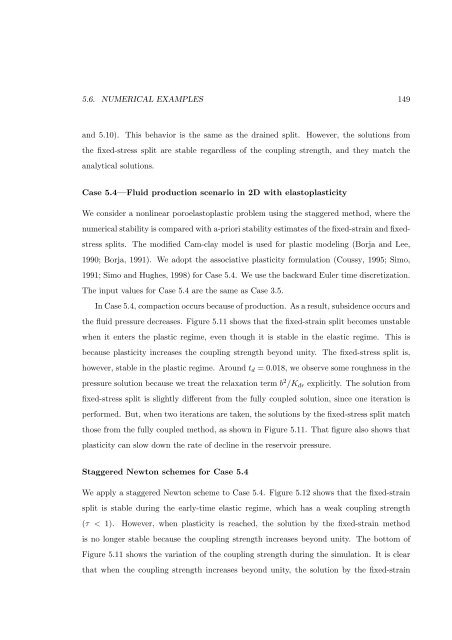Sequential Methods for Coupled Geomechanics and Multiphase Flow
Sequential Methods for Coupled Geomechanics and Multiphase Flow
Sequential Methods for Coupled Geomechanics and Multiphase Flow
You also want an ePaper? Increase the reach of your titles
YUMPU automatically turns print PDFs into web optimized ePapers that Google loves.
5.6. NUMERICAL EXAMPLES 149<br />
<strong>and</strong> 5.10). This behavior is the same as the drained split. However, the solutions from<br />
the fixed-stress split are stable regardless of the coupling strength, <strong>and</strong> they match the<br />
analytical solutions.<br />
Case 5.4—Fluid production scenario in 2D with elastoplasticity<br />
We consider a nonlinear poroelastoplastic problem using the staggered method, where the<br />
numerical stability is compared with a-priori stability estimates of the fixed-strain <strong>and</strong> fixed-<br />
stress splits. The modified Cam-clay model is used <strong>for</strong> plastic modeling (Borja <strong>and</strong> Lee,<br />
1990; Borja, 1991). We adopt the associative plasticity <strong>for</strong>mulation (Coussy, 1995; Simo,<br />
1991; Simo <strong>and</strong> Hughes, 1998) <strong>for</strong> Case 5.4. We use the backward Euler time discretization.<br />
The input values <strong>for</strong> Case 5.4 are the same as Case 3.5.<br />
In Case 5.4, compaction occurs because of production. As a result, subsidence occurs <strong>and</strong><br />
the fluid pressure decreases. Figure 5.11 shows that the fixed-strain split becomes unstable<br />
when it enters the plastic regime, even though it is stable in the elastic regime. This is<br />
because plasticity increases the coupling strength beyond unity. The fixed-stress split is,<br />
however, stable in the plastic regime. Around td = 0.018, we observe some roughness in the<br />
pressure solution because we treat the relaxation term b 2 /Kdr explicitly. The solution from<br />
fixed-stress split is slightly different from the fully coupled solution, since one iteration is<br />
per<strong>for</strong>med. But, when two iterations are taken, the solutions by the fixed-stress split match<br />
those from the fully coupled method, as shown in Figure 5.11. That figure also shows that<br />
plasticity can slow down the rate of decline in the reservoir pressure.<br />
Staggered Newton schemes <strong>for</strong> Case 5.4<br />
We apply a staggered Newton scheme to Case 5.4. Figure 5.12 shows that the fixed-strain<br />
split is stable during the early-time elastic regime, which has a weak coupling strength<br />
(τ < 1). However, when plasticity is reached, the solution by the fixed-strain method<br />
is no longer stable because the coupling strength increases beyond unity. The bottom of<br />
Figure 5.11 shows the variation of the coupling strength during the simulation. It is clear<br />
that when the coupling strength increases beyond unity, the solution by the fixed-strain
















